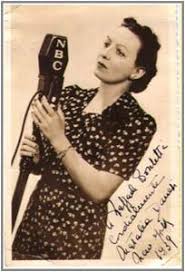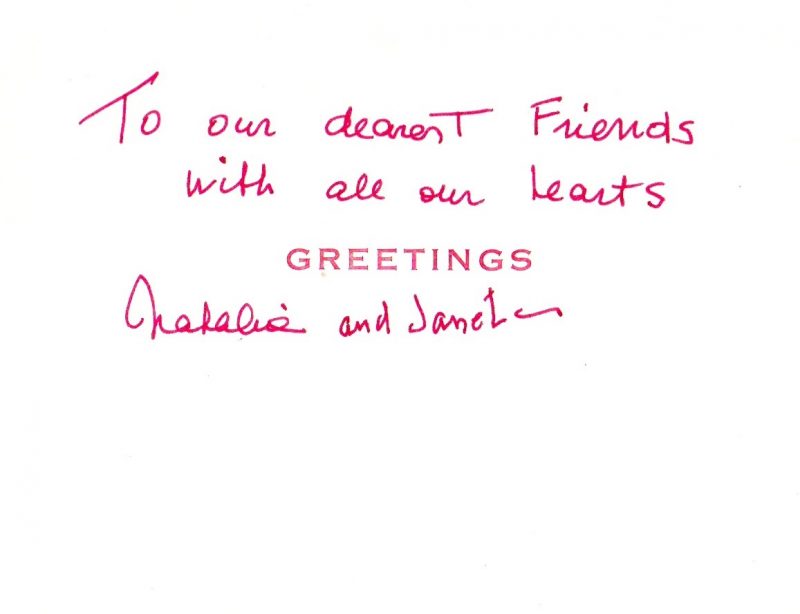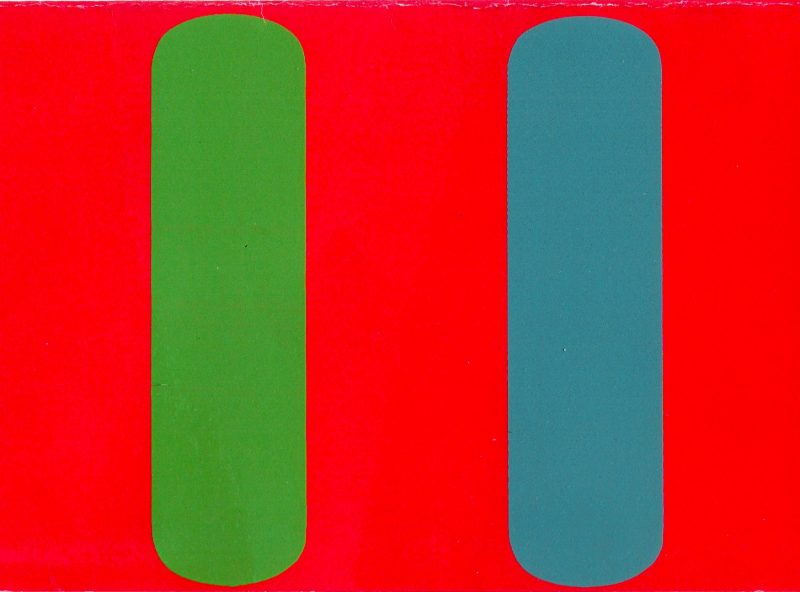Greeting Card Signed Janet Flanner & Natalia Murray
Greeting Card signed by Janet Flanner & lover Natalia Danesi Murray.
Measures 4.25 x 6 inches. Cover Artwork: Ellsworth Kelly, Blue Red, 1964. Oil on Canvas. Gift of the Friends of the Whitney Museum of American Art, 1977. New York, USA. ‘Greetings’ is pinted and handwritten in red ink: ‘To our deartest friends with all our hearts, Natalia and Janet’. Acquired in the 1990’s in New York, from the estate of friends of theirs.
Asking $225.
More Info:
Signed Genêt: Janet Flanner’s Letters from Paris
Janet Flanner (March 13, 1892 – November 7, 1978) was an American writer and journalist who served as the Paris correspondent of The New Yorker magazine from 1925 until she retired in 1975. She wrote under the pen name “Genêt”. She also published a single novel, The Cubical City, set in New York City.
Early life
Janet Flanner was born in Indianapolis, Indiana, to Frank and Mary Ellen Flanner (née Hockett). She had two sisters, Marie and Hildegarde Flanner. Her father co-owned a mortuary and ran the first crematorium in the state of Indiana. After a period spent traveling abroad with her family and studies at Tudor Hall School for Girls (now Park Tudor School), she enrolled in the University of Chicago in 1912, leaving the university in 1914. Two years later, she returned to her native city to take up a post as the first cinema critic on the local paper, the Indianapolis Star.
Marriage and Personal Life
In 1918 she married William “Lane” Rehm, a friend she had met while at the University of Chicago. He was then an artist in New York City, and she later admitted that she married him to get out of Indianapolis. The marriage lasted for only a few years and they divorced amicably in 1926. Rehm was supportive of Flanner’s career until his death.
In 1918, the same year she married her husband, she met Solita Solano in Greenwich Village, and the two became lifelong lovers, although both became involved with other lovers throughout their relationship. Solano was drama editor for the New-York Tribune, and also wrote for National Geographic. The two women are portrayed as “Nip” and “Tuck” in the 1928 novel Ladies Almanack, by Djuna Barnes, a friend of Flanner’s. While in New York, Flanner moved in the circle of the Algonquin Round Table, but was not a member. She also met the couple, Jane Grant and Harold Ross, through painter Neysa McMein. It was based on this connection that Harold Ross offered Flanner the position of French Correspondent to The New Yorker.
After these early years spent in Pennsylvania and New York in her mid twenties, Flanner left the United States for Paris.
Years as a War Correspondent
Flanner lived in New York City during World War II with Natalia Danesi Murray and her son William Murray (writer), still writing for The New Yorker. She returned to Paris in 1944. Her New Yorker work during World War II included not only her famous “Letter from Paris” columns, but also included a seminal 3-part series profiling Hitler (1936), and coverage of the Nuremberg trials (1945). Additionally, she contributed a series of little-known weekly radio broadcasts entitled “Listen: the Women” for the Blue Network during the months following the liberation of Paris in late August 1944. There is an iconic photograph of her sitting with Ernest Hemingway in the café Les Deux Magots taken shortly after the liberation.
Flanner authored one novel, The Cubical City, which achieved little success. In 1948 she was made a knight of Legion d’Honneur. She covered the Suez crisis, the Soviet invasion of Hungary, and the strife in Algeria which led to the rise of Charles de Gaulle. She was a leading member of the influential coterie of mostly lesbian women that included Natalie Clifford Barney and Djuna Barnes. Flanner lived in Paris with Solano, who put away her own literary aspirations to be Flanner’s personal secretary. Even though the relationship was not monogamous, they lived together for over 50 years.
Awards and recognitions[edit]
In 1958 Flanner was awarded an honorary doctorate by Smith College. In 1966 she won the U.S. National Book Award in the Arts and Letters category for her Paris Journal, 1944–1965. Extracts of her Paris Journal were turned into a piece for chorus and orchestra by composer Ned Rorem.
In 1971, she was the third guest during the infamous verbal scuffle between Gore Vidal and Norman Mailer on The Dick Cavett Show, getting in between the two after a drunken Mailer started insulting his fellow guests and their host.
In 2019, Park Tudor School — the school that formed after Tudor Hall for Girls (Flanner’s alma mater) merged with a nearby boys school — posthumously awarded her their prestigious “distinguished alumni award.” The school’s fine arts department also created a speaker series in her name, titled the “Janet Flanner Visit Artist Series.”
Later Life & Death
In 1975, Flanner returned to New York City permanently to be cared for by Natalia Danesi Murray. She died on November 7, 1978, of undetermined causes. Flanner was cremated, and her ashes were scattered along with Murray’s over Cherry Grove in Fire Island where the two had met in 1940, according to Murray’s son in his book Janet, My Mother, and Me.
Natalia Danesi Murray (December 14, 1901 – June 9, 1994) was a publishing executive and book editor. She was a key figure in promoting American writers to Italian readers. She was the longtime companion of the American writer Janet Flanner.
Early Life
Natalia Danesi was born in Rome in December 14, 1901. Her mother, Ester Danesi, was the editor of a women’s magazine, La Donna.
Her son wrote that, when a young woman, Natalia Danesi Murray was seduced by the soldier and writer Gabriele D’Annunzio.
In 1924 she emigrated to the United States.
Career
In the 1930s she was an actress on Broadway.
During World War II, from 1938 to 1944, she worked for an NBC radio program to broadcast short-wave news to Italy. In 1944 she was director of the press bureau of the Office of War Information in Rome. In 1945 she was head of the Special Projects Division of the United States Information Service in Rome. In 1946 she was a freelance correspondent in Italy.
In 1951, she became the head of the New York headquarters of Arnoldo Mondadori, the Italian publishing house. In 1966 she accepted the position of vice-president of the New York office of another Italian publisher, Rizzoli Editore, a position she covered until the 1970s. She was a key figure in promoting American writers to Italian readers.
In 1972 she was decorated with the Order of Cavaliere al Merito by the Italian Republic.
In 1979 she was the main stakeholder in the publishing of Janet Flanner’s World: Uncollected Writings, 1932-1975.
In 1985 she edited and commented the book “Darlinghissima: Letters to a Friend” by Janet Flanner, her longtime friend. The book is a collection of letters from Flanner to Danesi Murray; Danesi Murray called their relationship a “passionate friendship” which lasted from 1940 until Flanner’s death 1978.
Personal life
In 1924 she married William Murray (d. 1949), head of William Morris Agency in New York. They divorced in 1936.
From 1940 to 1978 she had a relationship with Janet Flanner, from 1940 to 1944 living together in New York City, and then long-distance, Danesi Murray living in New York, Flanner in Paris. Flanner had also other relationships and when Danesi Murray complained about that, Flanner replied: “You complain that I have three wives and the truth is, as you know, that I also have a husband, The New Yorker.”
She died on June 9, 1994, at Del Mar, California. She was cremated and her ashes, mingled with those of Janet Flanner, were scattered in Cherry Grove, New York, where, back in 1940, they met.
Legacy
Natalia Danesi Murray’s son, William Murray, wrote a book about growing up with her mother and the latter partner, Janet Flanner, Janet, my mother, and me (2000).
The Janet Flanner and Natalia Danesi Murray papers, 1940-1984 are hosted at the Library of Congress.




